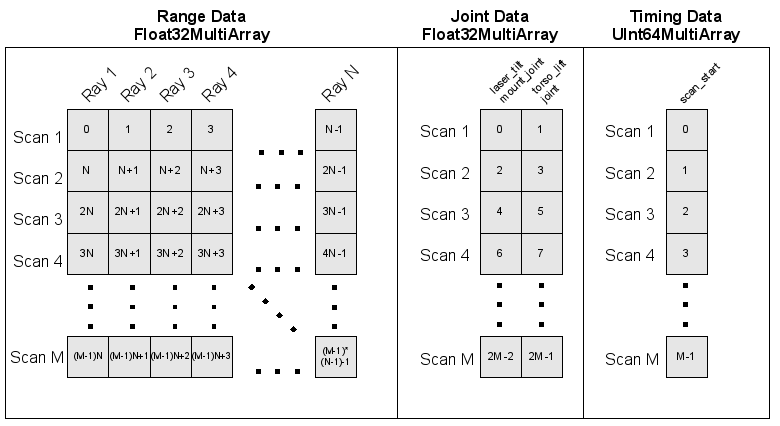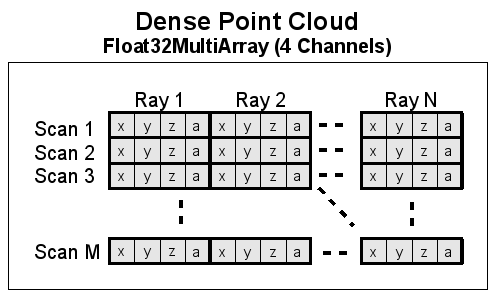Show EOL distros:
Package Summary
Stores streaming data from a laser sensor in a dense representation. This allows the user to do 'image-like' processing on the data, and can also be used for very fast approx neighborhood searches. This package is still experimental and unstable. Expect its APIs to change.
- Author: Vijay Pradeep
- License: BSD
- Repository: wg-ros-pkg
- Source: hg https://kforge.ros.org/calibration/pr2_calibration
Package Summary
Stores streaming data from a laser sensor in a dense representation. This allows the user to do 'image-like' processing on the data, and can also be used for very fast approx neighborhood searches. This package is still experimental and unstable. Expect its APIs to change.
- Author: Vijay Pradeep
- License: BSD
- Source: hg https://kforge.ros.org/calibration/pr2_calibration (branch: electric_trunk)
Package Summary
Stores streaming data from a laser sensor in a dense representation. This allows the user to do 'image-like' processing on the data, and can also be used for very fast approx neighborhood searches. This package is still experimental and unstable. Expect its APIs to change.
- Author: Vijay Pradeep
- License: BSD
- Source: hg https://kforge.ros.org/calibration/pr2_calibration (branch: default)
Package Summary
Stores streaming data from a laser sensor in a dense representation. This allows the user to do 'image-like' processing on the data, and can also be used for very fast approx neighborhood searches. This package is still experimental and unstable. Expect its APIs to change.
- Author: Vijay Pradeep
- License: BSD
- Source: hg https://kforge.ros.org/calibration/pr2_calibration (branch: default)
Package Summary
Stores streaming data from a laser sensor in a dense representation. This allows the user to do 'image-like' processing on the data, and can also be used for very fast approx neighborhood searches. This package is still experimental and unstable. Expect its APIs to change.
- Maintainer status: maintained
- Maintainer: Devon Ash <dash AT clearpathrobotics DOT com>
- Author: Vijay Pradeep
- License: BSD
- Source: git https://github.com/PR2/pr2_calibration.git (branch: hydro-devel)
Package Summary
Stores streaming data from a laser sensor in a dense representation. This allows the user to do 'image-like' processing on the data, and can also be used for very fast approx neighborhood searches. This package is still experimental and unstable. Expect its APIs to change.
- Maintainer status: maintained
- Maintainer: Devon Ash <dash AT clearpathrobotics DOT com>
- Author: Vijay Pradeep
- License: BSD
- Source: git https://github.com/PR2/pr2_calibration.git (branch: indigo-devel)
Package Summary
Stores streaming data from a laser sensor in a dense representation. This allows the user to do 'image-like' processing on the data, and can also be used for very fast approx neighborhood searches. This package is still experimental and unstable. Expect its APIs to change.
- Maintainer status: maintained
- Maintainer: Dave Feil-Seifer <dave AT cse.unr DOT edu>
- Author: Vijay Pradeep
- License: BSD
- Source: git https://github.com/UNR-RoboticsResearchLab/pr2_calibration.git (branch: kinetic-devel)
Package Summary
Stores streaming data from a laser sensor in a dense representation. This allows the user to do 'image-like' processing on the data, and can also be used for very fast approx neighborhood searches. This package is still experimental and unstable. Expect its APIs to change.
- Maintainer: Dave Feil-Seifer <dave AT cse.unr DOT edu>
- Author: Vijay Pradeep
- License: BSD
- Source: git https://github.com/UNR-RoboticsResearchLab/pr2_calibration.git (branch: kinetic-devel)
Stability
This package is still unstable, and does not have a released API.
Overview
Terminology
- Ray - A single range/intensity reading from a laser scanner. Takes approx 17 υs to acquire
- Scan - Data collected during a single revolution of a laser scanner. Takes approx 25 ms to acquire, and consists of 100's of rays
- Sweep - Data collected during monotonic motion of the tilting_stage on the PR2. Usually takes 2-10 seconds to acquire, and consists of 100's of scans
Intensity and Range data from a single sweep are each stored in their own Float32 multiarray. Each row of the multiarray stores data from a single scan, and these rows are stacked (sorted by the tilting angle) to form the 'rasterized' dense representation. Note that we are not doing any sort of perspective projection or interpolation or 'filling in' of the data. It is simply a set of stacked scans.
The assembler will also store timing and joint information. The positions of requested joints are stored in another multiarray, with the same number of rows as the range-data and intensity-data multiarrays. Depending on what fidelity we need, we could either store a joint position for the start of each scan, or a joint_position for each ray.
A 'typical' LaserScan message will also be published, providing config information for each scan. This includes info like min-angle, max-angle, angle-increment, time-increment, etc. Currently, we assume that the config information is consistent across all scans in a dense laser scan.

These multiarrays are convenient, since they look very similar to images. This makes it very easy to run openCV algorithms, such as checkerboard detection, on the intensity data.

Dense Point Clouds
Assuming a client receives the published data and also knows the pertinent parts of the robot's kinematics, the client can transform the laser data into a 'dense point cloud'. Ideally, this datatype will be used for both dense laser data and stereo data. The first 3 32-Bit fields will hold XYZ position data. The last 32-Bit field can hold auxiliary data, such as intensity. This aux data could hopefully also indicate whether the reading is valid. (eg. an intensity of 0 could imply an invalid range reading). Note that the indexing isn't changed between the dense_point_cloud and the original data, so both datasets can still easily be correlated.

It is likely that the DensePointCloud could end up using BinaryMultiArray as the underlying data structure.
If that is the case, then the scan stride can be chosen to be 16 bytes regardless of whether or not 3 channels (X,Y,Z) or 4 channels (X,Y,Z, validity) are used.







